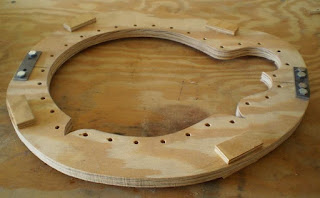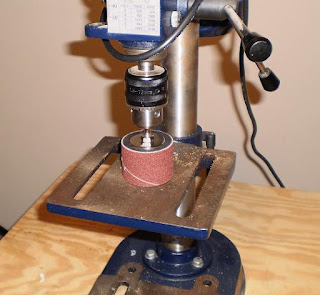Friday, February 13, 2009
Ok. Got quite a bit done over the last several days including getting sick (and well again), reading through my new book, making some templates, buying and making some additional tools, and getting started on the neck. Even though its more my nature to go straight from one thing to the next, I kept the camera near my workbench and thought to pause occasionally and snap off a few shots. For example (and just for fun) here are a few shots of my workbench and the larger tools I now have.



I got lucky, in terms of money, when I was talking to a buddy of mine who suggested that we could do some horse-swapping with tools. He had both a bench-top drill press and scroll saw that he no longer used while I had a small hobby lathe that I no longer used. This trade let me return my unopened scroll saw to Harbor Freight and get a much needed belt sander. Now I think I am pretty well set with all the large tools I need. Just a few more small ones.
As I said in my last post, the first thing I did before beginning to cut was to read through my new book and that is just what I did. Having finished it now, I find I am even more glad that I purchased and read through the first book before reading this one. Why? Because 1) there are several areas where each author spends a great deal of time focusing on details the other does not and 2) with as tough of a read as I found the first book to be, I probably would not have read through it like I should. Between these two reasons, assuming of course that I follow their directions, I feel confident I will end up with a better mandolin than I would have otherwise.
Aside from being a well written step-by-step how-to book, one of the best things about Roger Siminoff’s book, and one of the main reasons I bought it to begin with, is the fact that he includes a full set of full-sized template drawings in it. From these drawings, you can make what appears to be every necessary template and that is just where I started.
Because I hate the idea of destroying the original drawings that came with the book, I carefully removed them from the book (it is spiral bound with a plastic binding from which it is pretty easy to get pages out and in again) and scanned each into the computer using a printer-scanner-copier we already have at the house and then printed out. One of the things I had to make sure of (and one that Mr. Siminoff points out in the book) is that the software I used to print them delivered 100% sized prints (the first software I tried did not). The software I ended up using is a free one I downloaded from the Web called Serif PhotoPlus 6.0. Because my scanner and printer can only handle up to letter-sized documents, and many of the templates required larger printouts than this, I had to make multiple scans of most pages and then tape them together. This seemed to work out pretty well. Obviously if you don’t have a home scanner, you could take these to a local copy store and simply have copies made.
After I had all my templates made, I cut them out and laid them out on a sheet of 24” x 18” x 1/8” thick acrylic sheet and, once I was happy that with the layout, I glued them on with rubber cement. Here they are before gluing.

After gluing, I used the bandsaw to cut them out.
Next I decided it was time to get into the real thing. As per Mr. Siminoff’s direction, I started by laying out the pattern on the neck block and then cutting it out.
 FIRST MISTAKE
FIRST MISTAKE - Even though the book said to do it, I neglected to verify that my bandsaw and its table were set to give me a true 90 degree cut. Instead, it was just a little bit off which caused my initial cut on the peghead to be slightly under-cut. Fortunately I should be able to adjust for this when squaring up later.
The method that Mr. Siminoff uses to make his peghead is to glue “ears” on each side of the neck. This method does two things for you; first it allows you to use slightly smaller dimensioned blocks for you necks and, second, it lets you orient the grain in the main part of the neck and then reinforce the strength of the peghead by laminating on wood with straight grain. Because I knew I would be doing this, I made sure to save enough of the scrap from my neck block to create these two “ear” blocks from straight grained sections.

In this picture, you can see the profile I cut out and both ear blocks. The rectangle on the right is a sanding block I made by gluing a piece of medium grit sandpaper to a thin piece of acrylic. It is laying on a piece of paper to differentiate it from the workbench.
With the rough neck shape and both ear blocks now cut, it was time to start shaping the neck itself. For this I used a combination of a wood rasp, sand paper, and the Dremel tool and five neck gauge templates to check my progress as I went. I was quite surprised at how easy this step went. I was concerned that the neck shape would be difficult to get, but by using the gauges, I found that I was able to easily see where I needed to cut more and where I had done enough. I am really pleased with the results.




I also used the belt sander to dress my ears and peghead and then glued them together using hide glue.
Working with the hide glue turned out to be really easy, too. The directions say to mix by weight (not volume) 1 part dry glue chips to 1.8 parts water. To do this I got a small jelly jar and my wife’s diet scale. I put in about 10 grams of glue (a single increment on the scale) and then just short of 20 grams of water. By my keen eye :) I am sure it was right at 18 grams. Once mixed, I let it set one full day in the refrigerator and then heated it up the following night to 145 degrees using a pan of water on the stove.

I neglected to take a picture while it was actually heating, so this picture is a dramatic re-enactment and that is why the thermometer shows about 55 degrees.
Once the glue got to temperature, I ran (walked, actually) back upstairs with it and brushed it on and clamped the pieces up. After drying over night, it feels like a really tight hold.






























